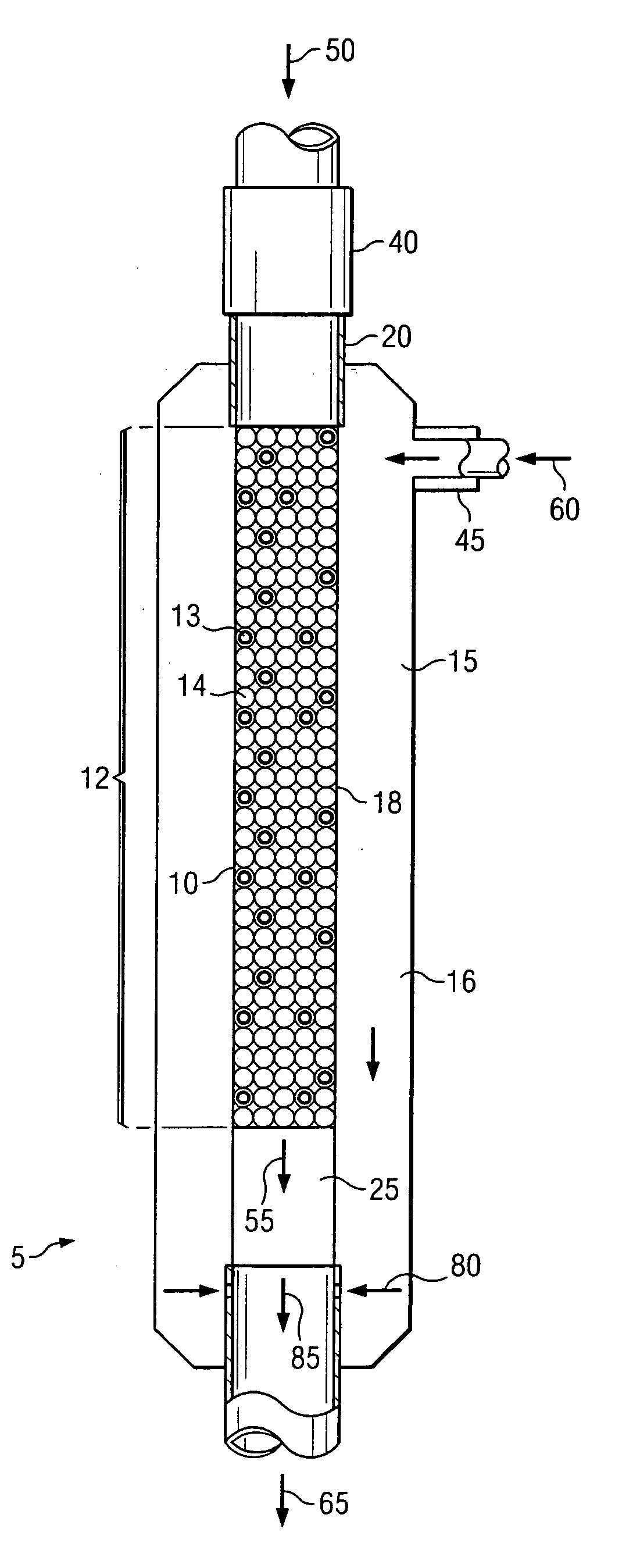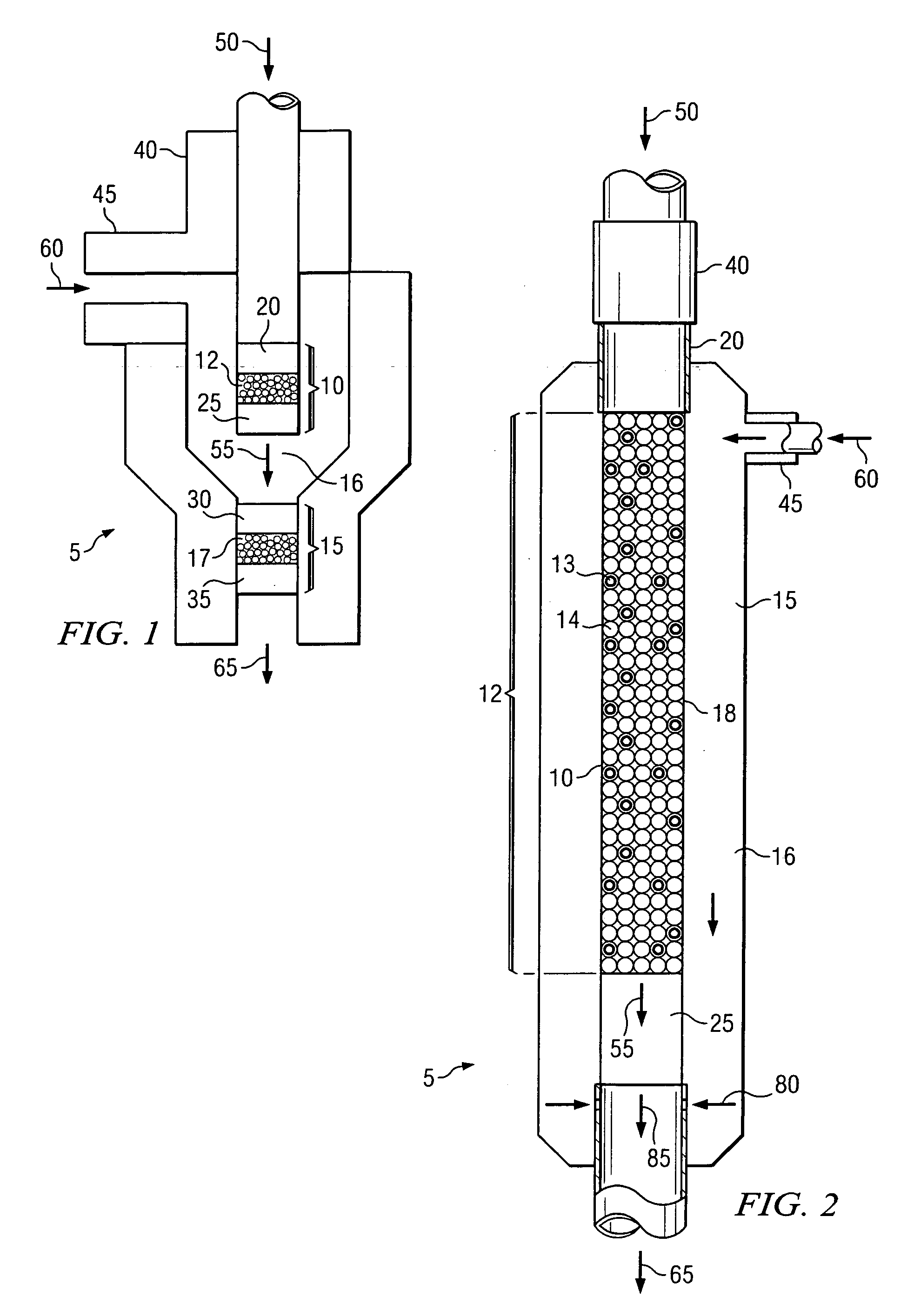Reactor and process for converting alkanes to alkenes
a technology of alkenes and reactors, applied in indirect heat exchangers, hydrocarbon preparation catalysts, lighting and heating apparatus, etc., can solve the problems of fcc and steam cracking, olefins are only slightly soluble in water, and the transport costs of the lower alkanes are generally prohibitiv
- Summary
- Abstract
- Description
- Claims
- Application Information
AI Technical Summary
Benefits of technology
Problems solved by technology
Method used
Image
Examples
examples 1-3
[0068] The experiments were performed in a ½ inch quartz reactor comprising a combustion zone comprising a ceramic shield and an alkene production zone. All experiments were conducted at approximately atmospheric pressure. Three Examples were performed to demonstrate the use of the heat from the combustion of carbon monoxide with O2 to initiate an alkene production reaction with ethane, O2 and optionally H2. The combustion zone feed, also called main feed, comprised CO, O2 and optionally H2, which were separately supplied via gas cylinders. The feed to the alkene production zone, called side feed, comprised ethane, O2, and optionally H2 and was not heated. The individual components of the side feed were mixed in a static mixer outside the reactor. The individual components of the main feed were mixed in a static mixer outside the reactor and heated before entering the combustion catalyst bed. The inlet temperature of the main feed, directly above the ceramic shield, was set at 400° ...
example 1
[0071] In Example 1, the second run condition (run 2A) involved H2 addition to the side feed, and the third run condition (run 3A) doubled the H2 flow, since co-fed H2 has been shown to increase ethylene selectivity. The fourth run condition (run 4A) involved maintaining the H2 flow in the side feed while increasing the ethane to O2 ratio in an effort to further increase ethylene selectivity.
[0072] The results of Example 1 are shown in Table 1. Each mole % in the table represents an average of 2-4 gas chromatograph analyses. The transition from condition 1A to condition 2A involved the addition of 0.25 liters per minute of H2. Ethane conversion dropped upon the addition of H2 while ethylene selectively improved. The transition from condition 2A to condition 3A involved the addition of another 0.25 liters per minute of H2. Again, ethane conversion decreased while ethylene selectivity increased. Changing from condition 3A to condition 4A involved increasing the ethane to oxygen ratio...
example 2
[0074] For Example 2, an alpha Al2O3 material was used as the second bed rather than the alkene production catalyst used in Example 1. Example 2 had five conditions 1B-5B. Conditions 1B-4B were the same as conditions 1A-4A of Example 1, and condition 5B employed an excess of oxygen in the main feed (see Table 3 for conditions). Example 2 was performed to introduce heated O2 to the ethane side feed to find out if the heated O2 would be more reactive. The same trends for ethane conversion and ethylene selectivity from Example 1 were seen in Example 2. Ethylene selectivity constantly increased from conditions 1B to 4B while ethane conversion constantly decreased. For condition 5B, ethane conversion increased with a slight fall in ethylene selectivity, indicating that the heated O2 is very reactive but responsible for some incremental combustion of ethane. The results of Example 2 are shown in Table 4.
TABLE 3Run Conditions for Example 2CarbonEthaneMonoxideOxygenOxygenNitrogenRunPrehea...
PUM
| Property | Measurement | Unit |
|---|---|---|
| Temperature | aaaaa | aaaaa |
| Temperature | aaaaa | aaaaa |
| Temperature | aaaaa | aaaaa |
Abstract
Description
Claims
Application Information
 Login to View More
Login to View More - R&D
- Intellectual Property
- Life Sciences
- Materials
- Tech Scout
- Unparalleled Data Quality
- Higher Quality Content
- 60% Fewer Hallucinations
Browse by: Latest US Patents, China's latest patents, Technical Efficacy Thesaurus, Application Domain, Technology Topic, Popular Technical Reports.
© 2025 PatSnap. All rights reserved.Legal|Privacy policy|Modern Slavery Act Transparency Statement|Sitemap|About US| Contact US: help@patsnap.com



